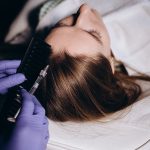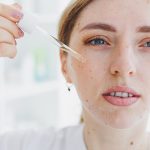1. Apply a Cold Compress
After a facial treatment, its common to experience some redness and swelling, especially if your skin is sensitive or the procedure involved extractions or exfoliation. One of the easiest and most effective ways to calm your skin is by applying a cold compress.
Gently press a cold compress or an ice pack wrapped in a clean, soft cloth onto the affected areas. This helps reduce inflammation by constricting blood vessels and numbing the area slightly, which also eases any discomfort or tenderness you might feel. Make sure not to apply ice directly to your skin, as this could cause irritation or even frostbite.
How to Use a Cold Compress Safely
| Step | Instructions |
|---|---|
| 1 | Wrap a few ice cubes or a cold gel pack in a clean washcloth |
| 2 | Apply gently to the red or swollen areas for 5–10 minutes |
| 3 | Remove the compress and let your skin rest for another 10 minutes before reapplying if needed |
This simple method can be done several times throughout the day as needed, especially within the first 24 hours after your facial. Always listen to your skin—if it feels too cold or uncomfortable, take a break.
2. Use Gentle, Soothing Skincare Products
After a facial treatment, your skin may feel sensitive, warm, or slightly inflamed. To help it heal faster and reduce redness and swelling, its important to choose skincare products that are gentle, calming, and hydrating.
Look for fragrance-free formulas—fragrances can irritate freshly treated skin. Instead, go for products with soothing ingredients like aloe vera, chamomile, or hyaluronic acid. These ingredients not only calm irritation but also provide moisture and support the skins natural barrier.
Top Ingredients to Look For
| Ingredient | Benefits |
|---|---|
| Aloe Vera | Soothes redness and inflammation; hydrates the skin |
| Chamomile | Calms irritated skin and reduces sensitivity |
| Hyaluronic Acid | Provides deep hydration without clogging pores |
Tips for Choosing the Right Products
- Avoid harsh chemicals: Skip products with alcohol, retinoids, or exfoliating acids right after your facial.
- Stick to minimal ingredients: The fewer ingredients, the lower the chance of irritation.
- Use a lightweight moisturizer: Helps lock in moisture without feeling heavy on the skin.
Your post-facial routine should focus on comfort and recovery. Think of it as giving your skin a break while still keeping it hydrated and protected.
![]()
3. Avoid Heat and Sun Exposure
After a facial treatment, your skin is more sensitive than usual. One of the most important things you can do to reduce redness and swelling is to avoid any kind of heat and direct sun exposure for at least 24 to 48 hours. Heat can dilate blood vessels, which may worsen the redness and prolong the healing process.
Why You Should Avoid Heat
Exposure to heat increases blood flow to the skin, which can intensify inflammation and irritation after a facial. This includes common everyday activities that you might not think twice about:
| Activity | Why to Avoid |
|---|---|
| Hot Showers | The steam and high temperature can open up pores even more, causing increased redness. |
| Saunas or Steam Rooms | The intense heat can trigger swelling and prolong skin sensitivity. |
| Hot Yoga or Intense Workouts | Sweating and elevated body temperature may irritate freshly treated skin. |
Protect Your Skin from the Sun
Direct sunlight can be especially harsh on post-facial skin. UV rays can worsen redness, cause pigmentation issues, and delay healing. Even on cloudy days, UV exposure can still affect your skin.
Tips to Stay Protected:
- Stay Indoors: Try to remain indoors during peak sun hours (10 AM – 4 PM).
- Use a Broad-Spectrum Sunscreen: Choose one with SPF 30 or higher, preferably mineral-based like zinc oxide or titanium dioxide.
- Wear Protective Clothing: If you need to go outside, wear a wide-brimmed hat and sunglasses for extra protection.
Important Reminder:
Your skin needs time to heal properly after a facial. Giving it a break from heat and sun exposure will help reduce discomfort, prevent additional redness, and promote better overall results.
4. Stay Hydrated and Maintain a Healthy Diet
After a facial treatment, your skin needs extra support to recover from any redness or swelling. One of the easiest and most effective ways to help your skin heal is by staying hydrated and eating a nutrient-rich diet. When you drink enough water and choose the right foods, youre giving your body the tools it needs to reduce inflammation and repair itself faster.
Drink Plenty of Water
Hydration is key. Drinking at least 8 glasses (64 ounces) of water per day helps flush out toxins from your system and keeps your skin cells plump and healthy. Well-hydrated skin can bounce back more quickly after treatments like facials, chemical peels, or microdermabrasion.
Choose Anti-Inflammatory Foods
Certain foods contain natural anti-inflammatory properties that can help calm your skin from the inside out. Try incorporating these into your meals:
| Food Type | Examples |
|---|---|
| Leafy Greens | Spinach, kale, arugula |
| Fruits High in Antioxidants | Blueberries, strawberries, oranges |
| Healthy Fats | Avocados, olive oil, walnuts |
| Omega-3 Rich Foods | Salmon, flaxseeds, chia seeds |
Avoid Inflammatory Foods
Just as some foods help reduce redness, others can make it worse. Try to avoid processed foods high in sugar, fried items, and anything with artificial additives during the healing phase.
Pro Tip:
If youre not a fan of plain water, try adding slices of cucumber or lemon for a refreshing twist that also offers extra nutrients.
5. Skip Harsh Products and Treatments
After a facial treatment, your skin can be extra sensitive and vulnerable. That’s why it’s important to hold off on using any strong or aggressive skincare products for a few days. These include exfoliants, retinoids, and products containing high concentrations of acids like glycolic acid or salicylic acid. Even though these ingredients are great for long-term skin health, they can be too harsh right after a facial and might cause more redness, stinging, or swelling.
What to Avoid Post-Facial
| Product Type | Why to Avoid |
|---|---|
| Exfoliants (scrubs, AHA/BHA toners) | Can cause microtears or over-exfoliation on freshly treated skin |
| Retinoids (retinol, tretinoin) | May increase sensitivity, dryness, or peeling |
| Strong Acids (glycolic acid, salicylic acid) | Might irritate and worsen redness or inflammation |
Gentle Alternatives You Can Use Instead
- Mild cleansers with no fragrance or alcohol
- Fragrance-free moisturizers with calming ingredients like aloe vera or ceramides
- Sunscreen with physical blockers like zinc oxide or titanium dioxide to protect sensitive skin from UV damage
Pro Tip:
If you’re unsure whether a product is safe to use after your facial, its best to wait a few days or check with your esthetician. Your skin needs time to heal and absorb the benefits of the treatment without interference from harsh ingredients.
6. Let Your Skin Rest
After a facial treatment, your skin needs time to heal and rebalance. One of the best things you can do is simply let it rest. Avoid applying makeup for at least 24 hours after your treatment. Makeup can clog pores and trap bacteria, which may lead to breakouts or increased redness. Your skin is more sensitive post-treatment, so giving it a break helps prevent irritation.
Another important tip: keep your hands off your face. Touching your skin unnecessarily can transfer dirt and oil, making any redness or swelling worse. It’s tempting to check on your skin’s progress, but letting it breathe without interference is key to a smooth recovery.
What to Avoid Right After a Facial
| Activity | Why to Avoid |
|---|---|
| Wearing makeup | Can clog freshly cleansed pores and cause irritation |
| Touching your face | Transfers bacteria and oils that may worsen redness |
| Using harsh skincare products | Might irritate sensitive post-facial skin |
Helpful Tips for Resting Your Skin
- Stick to gentle, hydrating skincare only
- Avoid exfoliants or active ingredients like retinol for 1–2 days
- Stay out of the sun and avoid heat exposure (like saunas)
Giving your skin the downtime it needs allows the benefits of your facial treatment to fully set in and reduces the chances of lingering redness or swelling.


